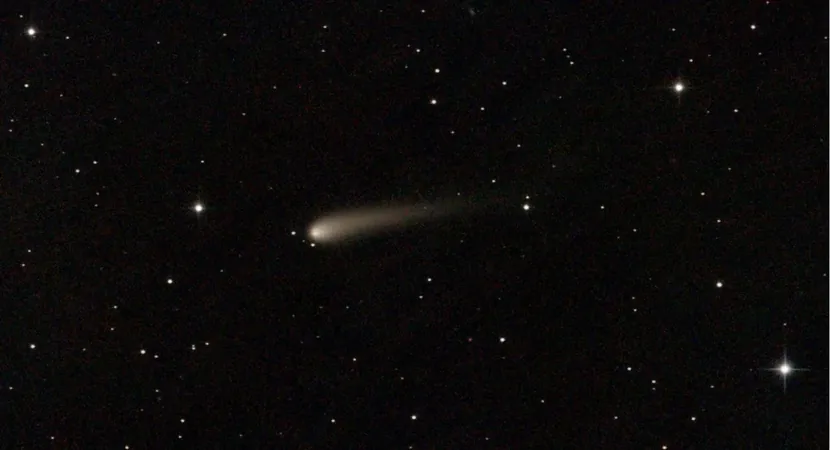
Get Ready for an October to Remember: A Rare Comet, Meteor Showers, and Celestial Wonders Await!
2024-09-30
Author: Jia
Introduction
As October unfolds, stargazers are in for a treat with the arrival of a newly discovered comet and spectacular meteor showers lighting up the night sky! Comet C/2023 A3, also known as Tsuchinshan-ATLAS, will be making its closest pass to Earth on October 12, coming within just 44 million miles—a distance that allows for a potentially breathtaking view from locations like New York City.
Expert Insights
Astrophysicist Jackie Faherty from the American Museum of Natural History emphasizes the excitement surrounding this celestial visitor. "Comets are unusual, brilliant, beautiful objects to look at," she notes, while adding a word of caution: "I tell people to keep an eye out and not to get everybody's hopes super high because comets can fizzle; as they get closer to the sun, they may break apart."
Comet C/2023 A3 Overview
Discovered in January 2023, Comet Tsuchinshan is particularly intriguing due to its two distinct tails—one white and one blue. Skywatchers hoping to catch a glimpse should aim for the period right after sunset, as the comet will be located in the constellation Ophiuchus, which resembles a man holding a snake.
Meteor Showers in October
October is not just about the comet; it's packed with stellar activities for astronomy enthusiasts. The month kicks off with the Draconids meteor shower, which starts on October 6 and peaks the following night, potentially offering up to 10 shooting stars per hour. These meteors radiate from the Draco constellation and are best viewed in the early evening over a span of five days. They travel at a leisurely pace of 12.5 miles per second, creating a spectacular show against the night sky.
The excitement continues with the Orionids meteor shower, set to peak on October 21. With double the shooting stars and speeds of up to 41 miles per second, these meteors are remnants of the famous Halley's Comet. Observers can start catching these shooting stars from late September through November 22.
Best Stargazing Tips
Faherty advises the best stargazing experience can be had from high rooftops or alongside the Hudson and East Rivers, where urban light pollution is minimized. "The higher up you go, the better chance you have of seeing more of the sky," she recommends, highlighting the need to unobstructedly view the heavens to catch every bright meteoric display.
Planetary Wonders
In addition to the dazzling meteors, four planets will grace our skies this month. Venus, the second brightest object in the night sky after the moon, will shine brightly just after sunset. On October 5, it will appear next to the waxing crescent moon. Jupiter, which ranks as the third brightest celestial object, becomes visible around 9:30 p.m., while Saturn is easily spotted with the naked eye. Mars makes its entrance later in the evening, peaking its head just before midnight, but by month’s end, it’ll rise earlier around 11 p.m.
Faherty adds, "October is a good month for planet watching," as many of these celestial bodies become particularly prominent.
Constellation Highlights
As fall unfolds, so do the constellations, with Orion leading the charge. One of the most recognizable shapes in the night sky, this hunter constellation is home to Rigel, one of the ten brightest stars visible to the naked eye. Additionally, the immense constellation Pegasus will be significant this month, with four bright stars forming a square that defines its body—Markab, Scheat, Algenib, and Alpheratz—with its brightest point located at the nose, Enif.
"The rise of Pegasus in the eastern sky is really a signal that autumn has arrived," Faherty states, making this October not just a month for celestial spectacles but also a celebration of the changing seasons. Get ready, star enthusiasts—this October is shaping up to be an astrological wonderland!






 Brasil (PT)
Brasil (PT)
 Canada (EN)
Canada (EN)
 Chile (ES)
Chile (ES)
 España (ES)
España (ES)
 France (FR)
France (FR)
 Hong Kong (EN)
Hong Kong (EN)
 Italia (IT)
Italia (IT)
 日本 (JA)
日本 (JA)
 Magyarország (HU)
Magyarország (HU)
 Norge (NO)
Norge (NO)
 Polska (PL)
Polska (PL)
 Schweiz (DE)
Schweiz (DE)
 Singapore (EN)
Singapore (EN)
 Sverige (SV)
Sverige (SV)
 Suomi (FI)
Suomi (FI)
 Türkiye (TR)
Türkiye (TR)